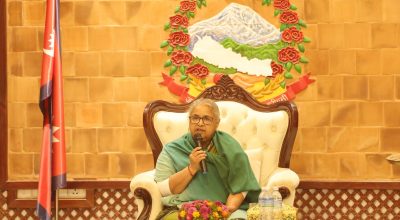
BEIJING – With China’s fertility rate having fallen off a cliff, many experts have offered a variety of advice for addressing the problem. But all of the proposals lack an essential component: a critical perspective on the role of gender.
Because the focus has been on the impact of high childrearing costs on fertility, the career penalty that women incur when they have a child has largely been overlooked. China’s policymakers would benefit greatly from the work of the Harvard University economist Claudia Goldin, who won the Nobel Prize for economics this year for her research advancing “our understanding of women’s labor-market outcomes.”
What does a gender-critical economics perspective suggest about China’s falling fertility rate? For starters, the growing literature on women’s labor-market outcomes shows that bearing a child can have significant negative effects on future employment prospects and salary.
This “parenthood penalty” is usually better understood to be a “motherhood penalty,” since it falls almost exclusively on women. The data make clear that women with children work and earn less than women without children, with some economists putting the parenthood penalty at around 20% of income.
Taking that figure as a benchmark, economists Yaohui Zhao, Xiaobo Zhang, and I looked into the lifetime income losses associated with childbirth in China, and found that they total to around $78,000. Previously, the YuWa Population Research Institute examined the costs of childbearing in China – from rising formula prices and housing rents to education-related expenses – and estimated that the bill from birth to age 18 comes to around $66,000. That is 6.9 times China’s per capita GDP, a ratio much higher than what one finds in the United States, France, or Germany.
But this figure accounts only for direct costs. When we add the parenthood penalty, the average total cost of raising a child in China could be as high as $144,000. While it may be around $84,000 in rural areas, it can be more than $300,000 in urban centers such as Beijing and Shanghai.
And these are just the quantifiable monetary costs. There are a dditional risks, such as those stemming from rising divorce rates and poorly regulated processes for assigning custody of children. When Jing Zhang of the Beijing Lawyers Association examined more than 700 cases involving custody rights, she found that children were forcibly separated or hidden from a parent – mostly by fathers – 13% of the time.
Since China’s rising divorce rate is a new phenomenon, laws and enforcement in this domain leave much to be desired. Cases of parents, often mothers with legal custody rights but deprived of access to their children, are not unusual.
As in most countries, Chinese working women also bear an unfair and disproportional burden when it comes to family care and household work. According to the World Bank, female labor-force participation in China is now 61.1% (much higher than global average of 50%), yet women do 2.6 times more unpaid domestic and care work than men.
It is no wonder that modern Chinese women are reluctant to have children. Like the working American women whom Goldin studies, Chinese women today are very different from their mothers and grandmothers. This is a generation that grew up with the one-child policy and the expansion of college enrollment for women starting in 1999. They have had far better educational opportunities, and they have benefited from the legacy of “reform and opening-up” and China’s accession to the World Trade Organization in 2001.
Having made educational, professional, and social gains that previous generations scarcely could have imagined, many Chinese women will no longer settle for the traditional model of marriage according to which men are the breadwinners and the bosses of the household, and women the subordinate homemakers. They refuse to accept that being a mother should be their entire identity.
Yet now that China’s fertility rate remains stubbornly low, there is renewed social pressure on women to “behave responsibly” by resuming their former roles. Parents are also urging their daughters to get married and have children, lest they become “leftover women” (those still single after age 27). But this pressure is merely adding to the burden and agitation that many aspiring working women bear.
Faced with overwhelming demands, many women are doing the opposite of what they are told and refusing to get married. This makes perfect sense. As long as they are single, they cannot be pressured to have babies and perform the overwhelming double duty of full-time professional and homemaker.
This is modern Chinese women’s silent strike. Exhausted from working both at the office and at home, women need men to step up and share more household and childcare responsibilities, and they need better policy and legal frameworks to account for gender inequities.
The solution to falling fertility rates thus cannot be only material or monetary in nature. Subsidizing childcare or kindergarten services is important, but so is doing more to ensure gender equality. China’s policies and social values should respect and promote women’s and men’s freedom of choice in work and/or at home. They need to recognize that many women long for career success, and they should encourage and celebrate men who share household and childcare responsibilities.
China benefits from its extraordinary powers to achieve policy goals. If Chinese policymakers take additional steps with more gender perspectives, they can enjoy more sustainable and healthy fertility rates, and help women truly “hold up half the sky.”
Qian Liu is Managing Director of the Economist Group in Greater China.
Copyright: Project Syndicate, 2023.
www.project-syndicate.org
















